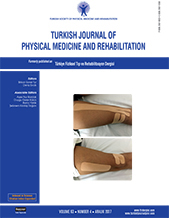Lumbrical-interosseus recording technique compared with routine electrodiagnostic methods in the diagnosis of carpal tunnel syndrome
2 Department of Physical Medicine and Rehabilitation, Medical Faculty of Marmara University, İstanbul, Turkey DOI : 10.5606/tftrd.2017.311 Objectives: We aimed to evaluate the sensitivity of second lumbrical-interosseous (L-I) technique and to compare the results with other electrophysiological methods in patients with carpal tunnel syndrome (CTS).
Patients and methods: This cross-sectional study was conducted in an electrophysiology laboratory of a university hospital between January 2003 and January 2004. A total of 102 patients with CTS (174 hands) and 40 healthy controls (80 hands) were included. Median motor nerve conduction studies were obtained with recordings from the abductor pollicis brevis (APB), median sensory nerve conduction studies from digits I-III and at palm-wrist segment (P-W), median-ulnar sensory comparison at digit IV (M-U), and median-radial sensory comparison at digit I (M-R) were along with L-I technique.
Results: The highest sensitivities were found in the median sensory conduction velocity across the palm-wrist (88%), and digit I-wrist segments (80%), median motor distal latency over the APB (77%), and L-I study (76%). The specificities of conventional tests were higher than the sensitivity of L-I method (63%).
Conclusion: L-I method has a good diagnostic sensitivity in CTS; however, P-W, median sensory nerve conduction velocity at digit I and median distal motor latency are more sensitive than L-I method. Therefore, L-I method can be applied as a supportive technique in the evaluation of patients with CTS.
Keywords : Carpal tunnel syndrome; electrophysiology; median neuropathy; nerve conduction study
















